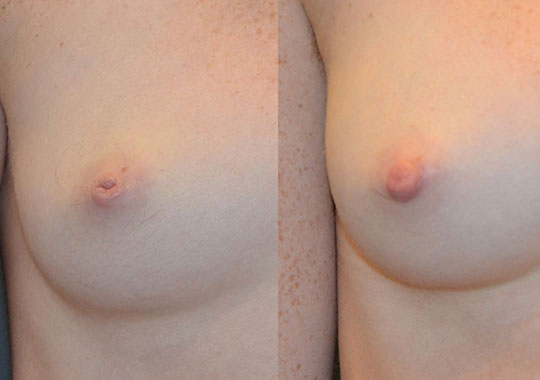New York plastic surgeon Dr. Preminger performs inverted nipple repair – both surgical under local anesthesia and non-surgical – in her Park Avenue, Manhattan suite.
Want to learn more about inverted nipple surgery in NYC? Request a consultation today.
Inverted Nipple Surgery in NYC
An estimated 10 to 20 percent of all women have inverted nipples, which can cause feelings of self-consciousness and embarrassment. While this condition can also happen in men, it is fortunately an easy one to remedy with both surgical and non-surgical cosmetic breast treatments.
Before & After

Inverted nipple correction surgery
Patients with one or two inverted nipples may lack confidence when it comes to the appearance of their breasts, especially during intimate occasions. Inverted nipples, where the nipples are flat or concave, are a totally natural breast variation that many people are born with. For some patients, nipple inversion will spontaneously resolve during puberty or pregnancy, while others may develop inverted nipples during these times. Although inverted nipples are completely painless, the condition can make breasts look asymmetrical and distorted. In the most severe cases, inverted nipples can even interfere with breastfeeding.
Dr. B. Aviva Preminger offers inverted nipple surgery in NYC under local anesthesia, helping women (and men) boost their self-esteem and confidence. Before recommending a treatment plan, Dr. Preminger will examine your breasts to assess the degree of severity.
- Level 1 – Nipples are only mildly inverted and can usually be fixed with a manual release and stretch of the tissue.
- Level 2 – Nipples are not likely to correct themselves spontaneously, and may respond to non-surgical manipulation with suction or surgery.
- Level 3 – This category is the most severe type of nipple inversion that will only respond to inverted nipple surgery.
After your personal consultation and physical exam, Dr. Preminger will outline one of the best options, and if inverted nipple correction surgery is necessary, you will have the chance to tour her state-of-the-art surgical suite situated on the upper east side of Manhattan.
Can I still breastfeed after inverted nipple repair?
In order to surgically evert nipples that are categorized as grade 2 or grade 3, there will likely be some trauma to the milk ducts, which can affect breastfeeding ability. Women who are planning on having children and breastfeeding are encouraged to wait until after they are finished before having inverted nipple repair.
While much care is made to preserve the lactiferous ducts and nerves, each case is different, and some patients may find that after the surgery they are unable to breastfeed. Dr. Preminger ensures that all patients have thorough knowledge of the risks and benefits of the procedure, so they can make informed decisions.
Inverted nipple surgery recovery
Patients can expect a short recovery with little downtime, and are back at work within two days. A special dressing is placed over the nipples after the surgery, and patients may experience some mild swelling and tenderness. Avoiding strenuous activities for the first two weeks can help expedite the healing process and best of all – the results are evident immediately! Most patients will notice normal fully everted nipples right after the procedure, and the results are generally permanent.
Dr. Preminger understands the impact that inverted nipples can have on confidence and relationships, and is proud to offer her expertise and talent to patients in need. To make an appointment for a private consultation, please call (212) 706-1900.
